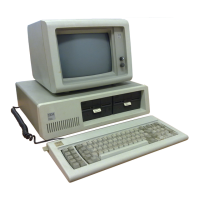control lines, memory refresh timing control lines, a
channel-check line, and power and ground for the adapters. Four
voltage levels are provided for
I/O
cards:
+5
Vdc, -5 Vdc, + 12
Vdc, and -12 Vdc. These functions are provided in a 62-pin
connector with 100-mil card tab spacing.
A 'ready' line
is
available
on
the
I/O
channel to allow operation
with slow
I/O
or memory devices.
If
the channel's ready line
is
not activated by an addressed device, all
microprocessor-generated memory read and write cycles take four
21O-ns clocks or
840-ns/byte.
All microprocessor-generated
I/O
read and write cycles require five clocks for a cycle time
of
1.05-.us/byte. All
DMA
transfers require five clocks for a cycle
time of 1.05-.us/byte. Refresh cycles occur once every
72
clocks
(approximately
15-.us)
and require four clocks or approximately
7
%
of
the bus bandwidth.
I/O
devices are addressed using
I/O
mapped address space. The
channel is designed so that 512
I/O
device addresses are available
to the
I/O
channel cards.
A 'channel check' line exists for reporting error conditions to the
~
microprocessor. Activating this line results in a non-maskable
interrupt (NMI) to the 8088 microprocessor. Memory expansion
options use this line to report parity errors.
The
I/O
channel
is
repowered to provide sufficient drive to power
all five system unit expansion slots, assuming two low-power
Schottky loads per slot. The IBM
I/O
adapters typically use only
one load.
System Board
1-1
S

